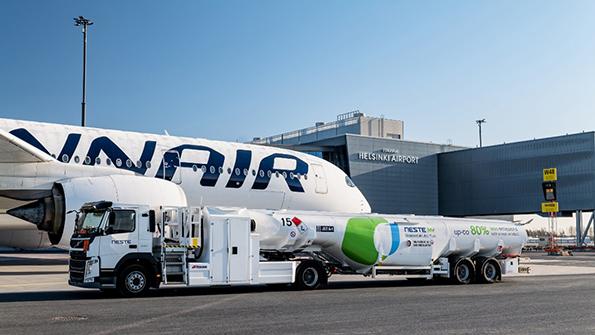ANALYSIS: Sustainable Aviation Fuel The Key And The Challenge For Future Flying

With air traffic flights and passengers drastically down in 2020, the 2019 top issues of aircraft emissions and “flight shame” have all but disappeared. But they will reappear just as soon as traffic recovers.
“As we come out of the coronavirus, climate change and airlines’ reaction to it will be front and center,” JetBlue Airways CEO Robin Hayes told the Global Sustainable Aviation Forum in September. And at least some of the money now being loaned to airlines by governments will have to go into environmental projects, he said.
“I really don’t think we have a choice. Customers will demand it. Governments and regulators will increasingly pay attention to it,” he said.
With that in mind, one of the most repeated comments of the forum, staged by the not-for-profit organization Air Transport Action Group (ATAG), was the need to scale up and accelerate production of sustainable aviation fuels (SAF).
SAF, several speakers commented, is the only short- to medium-term option for the airline industry if it is to reach decarbonization targets, notably the industry’s pledge to reduce emissions to 50% of 2005 levels by 2050.
The world’s fuel producers are starting to put real resources behind this, but the task they face is vast. Today’s SAF production capacity is around 20,000 tonnes annually; that will have to expand to as much as 500 million tonnes by 2050 to meet anticipated demand. That will require huge investment from both refiners and governments—the latter possibly through taxation systems to give incentives for new production facilities.
The coming decade will be critical in expanding production exponentially.
“2050 seems a long way away, but unless we break the back of this in the next 10 years, we won’t get there,” London Heathrow Airport CEO John Holland-Kaye said. “Let’s not waste biofuels on trucks and cars.”
There were other options for powering vehicles, but no alternatives to SAF for decarbonizing aviation, Holland-Kaye pointed out.
He added that if European countries and the US followed Sweden’s lead in declaring a mandate to have 30% of aviation fuel produced from sustainable sources by 2030, “that would send a really important message to producers … that demand is really there.”
As well as investing in infrastructure, producers will also have to turn their attention to finding more raw materials, as no single existing feedstocks, whether waste cooking fats, plant-derived oils or agricultural residues, will be able to generate sufficient volumes of SAFs.
Equally important is the need for airlines to lock up SAF supplies quickly, suggested Grace Cheung, head of public engagement and sustainability at Cathay Pacific Airways, which has committed to take 17 million gallons of SAF over the coming decade.
“It takes time for SAF to scale up. Get in early to secure supply at a reasonable price,” she said. Cheung also suggested that by demonstrating this commitment, airlines could encourage investors to engage in the SAF sector.
Cost Gap
Several speakers said governments need to play a part in multiple ways, not least in bridging the gap in price between kerosene and SAF, with the latter currently costing around six times as much as Jet A-1. Intelligent use of the taxation system could help in that regard.
More fundamentally, however, putting in place the refining infrastructure to vastly increase output of SAFs may require government financial assistance. To encourage the production of greater quantities of SAFs, it would also be useful to have national mandates to reach a certain level of SAF usage in industry generally—not just the aviation sector—by set timelines.
However, it has become increasingly clear that there is no single silver bullet when it comes to sustainability. In the longer term, hydrogen is clearly the fuel of choice and, to act as a bridge to get there, electric power will take its place alongside SAF. A large-scale take-up of batteries as a supplementary power source will require airports to invest massively in recharging facilities.
Given that the maximum size of an aircraft in which electric power is regarded as a viable fuel is a 50- to 100-seater, that suggests smaller regional airports will have to make significant investments in charging points.
Like current-generation SAFs, huge investment will be required to boost hydrogen production. At present, some 60 million tonnes are produced annually. That will need to rise to around 800 million tonnes per year in 2050, although much of that total will go to other industrial sectors.


